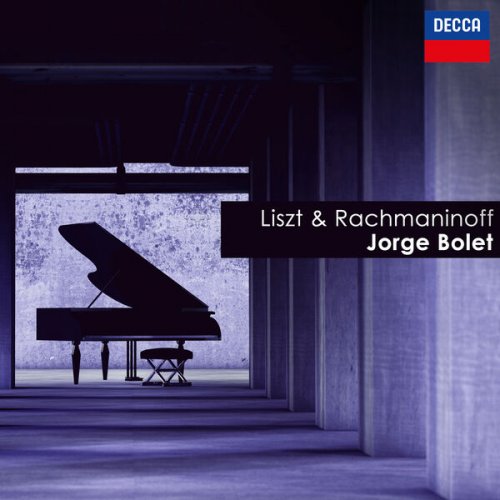
Jorge Bolet - Liszt & Rachmaninoff: Jorge Bolet (2023)
BAND/ARTIST: Jorge Bolet
- Title: Liszt & Rachmaninoff: Jorge Bolet
- Year Of Release: 2023
- Label: UMG Recordings, Inc.
- Genre: Classical
- Quality: FLAC (tracks)
- Total Time: 2:04:03
- Total Size: 360 MB
- WebSite: Album Preview
Tracklist:
01. Liszt: Ständchen ("Horch, horch! die Lerch"), S.558 No. 9 (after Schubert, D.889)
02. No. 1 Prélude (Presto)
03. Rachmaninoff: Prélude in G sharp minor, Op. 32, No. 12
04. Rachmaninoff: Prelude in F, Op. 32, No. 7
05. Rachmaninoff: Prélude in G flat, Op. 23, No. 10
06. Liszt: Consolation No. 1, Andante con moto, S.172, No. 1
07. Liszt: Die Post, S.561 No. 4 (after Schubert, D.911)
08. 3. Pastorale
09. Liszt: Wohin?, S.565, No. 5 (after Schubert, D.795)
10. Liszt: Consolation No. 5, Andantino
11. No. 2 Molto vivace
12. Rachmaninoff: Prélude in C sharp minor, Op. 3, No. 2
13. Rachmaninoff: Prelude in G minor, Op. 23, No. 5
14. Rachmaninoff: Melodie in E, Op. 3, No. 3
15. Liszt: Das Wandern, S.565 No. 1 (after Schubert, D.795)
16. 3. Canzonetta del Salvator Rosa
17. No. 2, Gnomenreigen
18. 2. Au lac de Wallenstadt
19. Liszt: Consolation No. 4, Quasi Adagio
20. Liszt: Consolation No. 6, S.172 No. 6
21. Liszt: Consolation No. 2, S.172 No. 2
22. 7. Eglogue
23. Liszt: Aufenthalt, S.560 (after Schubert, D.957)
24. No. 3 in D-Flat Major. Lento placido
25. 2. Il Pensieroso
26. No. 3 Paysage (Poco adagio)
27. No. 2 in E-Flat Major "Seliger Tod"
28. Liszt: Lebe Wohl!, S.563, No. 1 (after Schubert, D.578)
29. 2. Canzone
30. No. 1 Waldesrauschen
31. No. 3, Oh Lieb, so lang du lieben kannst
32. No. 4, Au bord d'une source
33. 5. Orage
34. No. 5 Feux follets (Allegretto)
35. Liszt: Grand Galop Chromatique, S.219
01. Liszt: Ständchen ("Horch, horch! die Lerch"), S.558 No. 9 (after Schubert, D.889)
02. No. 1 Prélude (Presto)
03. Rachmaninoff: Prélude in G sharp minor, Op. 32, No. 12
04. Rachmaninoff: Prelude in F, Op. 32, No. 7
05. Rachmaninoff: Prélude in G flat, Op. 23, No. 10
06. Liszt: Consolation No. 1, Andante con moto, S.172, No. 1
07. Liszt: Die Post, S.561 No. 4 (after Schubert, D.911)
08. 3. Pastorale
09. Liszt: Wohin?, S.565, No. 5 (after Schubert, D.795)
10. Liszt: Consolation No. 5, Andantino
11. No. 2 Molto vivace
12. Rachmaninoff: Prélude in C sharp minor, Op. 3, No. 2
13. Rachmaninoff: Prelude in G minor, Op. 23, No. 5
14. Rachmaninoff: Melodie in E, Op. 3, No. 3
15. Liszt: Das Wandern, S.565 No. 1 (after Schubert, D.795)
16. 3. Canzonetta del Salvator Rosa
17. No. 2, Gnomenreigen
18. 2. Au lac de Wallenstadt
19. Liszt: Consolation No. 4, Quasi Adagio
20. Liszt: Consolation No. 6, S.172 No. 6
21. Liszt: Consolation No. 2, S.172 No. 2
22. 7. Eglogue
23. Liszt: Aufenthalt, S.560 (after Schubert, D.957)
24. No. 3 in D-Flat Major. Lento placido
25. 2. Il Pensieroso
26. No. 3 Paysage (Poco adagio)
27. No. 2 in E-Flat Major "Seliger Tod"
28. Liszt: Lebe Wohl!, S.563, No. 1 (after Schubert, D.578)
29. 2. Canzone
30. No. 1 Waldesrauschen
31. No. 3, Oh Lieb, so lang du lieben kannst
32. No. 4, Au bord d'une source
33. 5. Orage
34. No. 5 Feux follets (Allegretto)
35. Liszt: Grand Galop Chromatique, S.219
Virtuoso pianist Jorge Bolet began his keyboard studies at the age of nine. His progress excited his local teachers and he received a scholarship at the age of 12 to study in the United States, at the Curtis Institute of Music in Philadelphia. There his piano teacher was David Saperton. Beginning in 1932 he studied with Leopold Godowsky and Moritz Rosenthal, and, briefly, with Rudolf Serkin. He won the Naumburg Prize in 1937 and the Josef Hofmann Award in 1938. He became Rudolf Serkin's teaching assistant at the Curtis Institute in 1939. In 1942 he joined the United States armed forces. After the end of the war he was a part of the U.S. cccupying forces in Japan. There, he conducted the first performance in that country of Gilbert and Sullivan's The Mikado. He resumed his piano career after taking private lessons with Abram Chasins. Over a period of a few years he developed a reputation as a virtuoso player of astonishing power, able to play the most difficult works by Liszt with an impression of natural ease that left the feeling that there was no limit to his pianistic range. He became the head of the piano faculty at Curtis, and also was on the piano faculty of Indiana University at Bloomington. While in the United States he preferred the pronunciation "George" for his first name.
Until nearly the end of his life he maintained a major performing and recording career. His recordings were primarily for the Decca (London) company. He produced many estimable performances, notably those of the major piano works by Franz Liszt, as well as concertos and other works. As exciting as some of these recordings were, he was an artist whose full range of brilliance was not caught by the microphone. © Joseph Stevenson
Until nearly the end of his life he maintained a major performing and recording career. His recordings were primarily for the Decca (London) company. He produced many estimable performances, notably those of the major piano works by Franz Liszt, as well as concertos and other works. As exciting as some of these recordings were, he was an artist whose full range of brilliance was not caught by the microphone. © Joseph Stevenson
Year 2023 | Classical | FLAC / APE
As a ISRA.CLOUD's PREMIUM member you will have the following benefits:
- Unlimited high speed downloads
- Download directly without waiting time
- Unlimited parallel downloads
- Support for download accelerators
- No advertising
- Resume broken downloads


